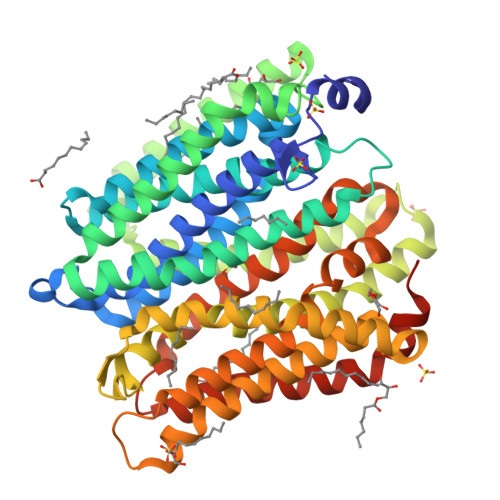Structural basis for dynamic mechanism of proton-coupled symport by the peptide transporter POT.
Doki, S., Kato, H.E., Solcan, N., Iwaki, M., Koyama, M., Hattori, M., Iwase, N., Tsukazaki, T., Sugita, Y., Kandori, H., Newstead, S., Ishitani, R., Nureki, O.(2013) Proc Natl Acad Sci U S A 110: 11343-11348
- PubMed: 23798427
- DOI: https://doi.org/10.1073/pnas.1301079110
- Primary Citation of Related Structures:
4IKV, 4IKW, 4IKX, 4IKY, 4IKZ - PubMed Abstract:
Proton-dependent oligopeptide transporters (POTs) are major facilitator superfamily (MFS) proteins that mediate the uptake of peptides and peptide-like molecules, using the inwardly directed H(+) gradient across the membrane. The human POT family transporter peptide transporter 1 is present in the brush border membrane of the small intestine and is involved in the uptake of nutrient peptides and drug molecules such as β-lactam antibiotics. Although previous studies have provided insight into the overall structure of the POT family transporters, the question of how transport is coupled to both peptide and H(+) binding remains unanswered. Here we report the high-resolution crystal structures of a bacterial POT family transporter, including its complex with a dipeptide analog, alafosfalin. These structures revealed the key mechanistic and functional roles for a conserved glutamate residue (Glu310) in the peptide binding site. Integrated structural, biochemical, and computational analyses suggested a mechanism for H(+)-coupled peptide symport in which protonated Glu310 first binds the carboxyl group of the peptide substrate. The deprotonation of Glu310 in the inward open state triggers the release of the bound peptide toward the intracellular space and salt bridge formation between Glu310 and Arg43 to induce the state transition to the occluded conformation.
Organizational Affiliation:
Department of Biophysics and Biochemistry, Graduate School of Science, The University of Tokyo, Bunkyo-ku, 113-0033 Tokyo, Japan.






















